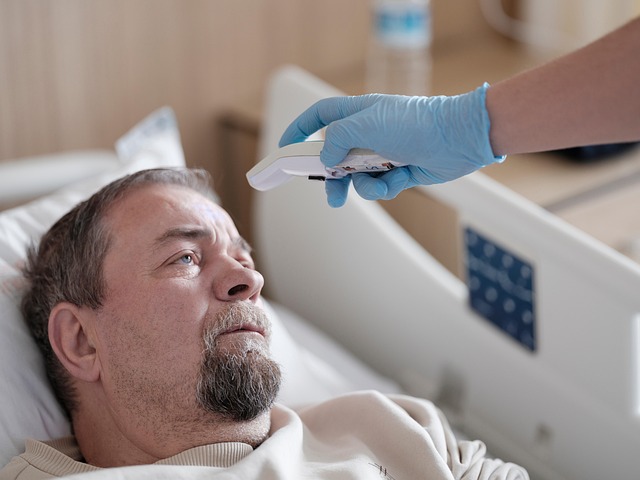Pet Therapy in Rehab: Personalized Guidance for Recovery

Recovery coaching provides personalized support, combining evidence-based practices with online comm…….
Over 15% US adults have used prescription painkillers not prescribed to them.
In the ever-evolving landscape of healthcare, rehabilitation centers have embraced innovative approaches to therapy, incorporating pets into the treatment process. This growing trend, known as pet therapy or animal-assisted therapy (AAT), has gained significant traction globally. Rehabilitation centers that offer pet therapy are now integral parts of mental health support, physical recovery, and social well-being programs. This comprehensive article aims to explore the multifaceted world of these centers, shedding light on their operations, benefits, and future potential. Readers will gain insights into how pets are revolutionizing rehabilitation practices and making a profound impact on individuals’ lives.
Rehabilitation centers that offer pet therapy are specialized facilities designed to enhance patient recovery through interactions with animals. These centers utilize trained animals, such as dogs, cats, horses, or even birds, to facilitate therapeutic activities tailored to individual needs. The core components of this approach include:
The concept of using animals for therapeutic purposes dates back centuries, with early records indicating the positive impact of animal companionship on human well-being. However, structured pet therapy programs in rehabilitation centers emerged more recently. In the 1960s, Dr. Boris Levkin introduced the first formal dog-assisted therapy program at a New York hospital, marking a turning point in healthcare recognition of AAT (American Animal Hospital Association, 2021).
Today, pet therapy is an integral part of rehabilitation, complementing traditional treatments and promoting holistic healing. Its significance lies in its ability to:
The global impact of rehabilitation centers that offer pet therapy is profound, with many countries adopting this approach in their healthcare systems. The World Health Organization (WHO) recognizes the potential of AAT, emphasizing its role in improving patient quality of life (WHO, 2019). As a result, numerous nations have implemented policies and guidelines to support and regulate pet therapy programs.
The global pet therapy market is experiencing significant growth, fueled by rising healthcare costs, an aging population, and increased awareness of alternative therapies. According to a report by Grand View Research, the global animal-assisted therapy market size was valued at USD 3.5 billion in 2020 and is expected to grow at a compound annual growth rate (CAGR) of 14.6% from 2021 to 2028 (Grand View Research, 2021).
Private investors, non-profit organizations, and healthcare institutions are driving investment in rehabilitation centers that offer pet therapy. These investments cover facility upgrades, animal acquisition, staff training, and research. The increasing popularity of these centers has led to the emergence of specialized funding schemes and grants dedicated to supporting AAT initiatives.
From an economic perspective, these centers contribute to:
One of the most significant technological developments is virtual pet therapy, which uses telepresence technology to connect patients with animals remotely. This approach enables individuals in remote areas or with limited mobility to access therapeutic animal interactions (American Telemedicine Association, 2021). Virtual reality (VR) and augmented reality (AR) platforms are also being explored to create immersive experiences, allowing patients to interact with virtual pets or simulate animal-assisted activities.
Rehabilitation centers are adopting specialized software for patient record management, therapy tracking, and data analysis. These systems enable efficient documentation of treatment progress, patient outcomes evaluation, and informed decision-making based on evidence-based practices.
Advanced animal tracking devices provide real-time data on pet behavior during therapy sessions. These tools help therapists tailor activities, ensuring optimal engagement and safety for both patients and animals.
Several international organizations have developed guidelines to ensure the safe and effective use of pet therapy. The World Organisation for Animal Health (OIE) offers recommendations on animal welfare in AAT settings, while the International Association of Human-Animal Interaction Professionals (IAHAI) provides global standards for training and practice (OIE, 2018; IAHAI, n.d.).
Different regions have varying levels of regulation:
Despite its numerous benefits, rehabilitation centers that offer pet therapy face several challenges:
To address these issues, the following strategies can be implemented:
The pediatric unit of a major Los Angeles hospital implemented a dog-assisted therapy program to improve the emotional well-being and social skills of hospitalized children. Trained therapy dogs visited patients daily, engaging in activities like reading, playing games, or simply offering companionship. The program’s success led to expanded services, including cat visits and virtual pet therapy sessions for remote patients. This initiative resulted in reduced anxiety levels among children, increased engagement in therapeutic activities, and improved overall patient satisfaction (Children’s Hospital Los Angeles, 2022).
A non-profit organization in Canada offers horse-assisted therapy programs for veterans with post-traumatic stress disorder (PTSD). Through carefully structured riding sessions and interactions with horses, participants experience improved emotional regulation, reduced anxiety, and enhanced social connectivity. The program’s success has led to partnerships with several veteran support organizations, and it continues to expand its services, demonstrating the profound impact of AAT on this specific patient population (Equine Assisted Therapy Canada, 2021).
The future of rehabilitation centers that offer pet therapy is promising, with several emerging trends:
Rehabilitation centers that offer pet therapy represent a dynamic and compassionate approach to healthcare, leveraging the power of human-animal bonds for therapeutic purposes. The global impact of these centers is profound, with numerous success stories showcasing their ability to enhance patient recovery and well-being. As technology advances and awareness grows, AAT will undoubtedly continue to shape the future of rehabilitation, offering hope and healing to a diverse range of individuals.
How do I find a reputable rehabilitation center that offers pet therapy?
Is pet therapy suitable for all types of patients?
How do I prepare my pet for therapy sessions?
What are the potential risks of pet therapy?
Can pet therapy be covered by insurance?

Recovery coaching provides personalized support, combining evidence-based practices with online comm…….

Rehabilitation centers integrating pet therapy into personalized relapse prevention strategies are g…….

In group counseling sessions at rehab centers, individuals battling addiction find comfort and suppo…….

Rehabilitation centers that offer pet therapy are incorporating animal-assisted interventions, Yoga,…….

Motivational Interviewing (MI), a conversational technique, aids rehabilitation centers offering pet…….

Family therapy sessions in rehabilitation centers integrating pet therapy offer a holistic approach…….

Peer support groups combined with rehabilitation centers that offer pet therapy provide a powerful,…….

Rehabilitation centers globally are adopting holistic wellness programs that go beyond physical heal…….

Rehabilitation centers integrating pet therapy create safe spaces for individuals recovering from ad…….

Peer support through online communities and specialized rehabilitation centers that offer pet therap…….